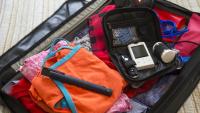Traveling with Diabetes

Preparation is key when traveling with diabetes. It is important to obtain a travel letter from the Naomi Berrie Diabetes Center and keep it handy at all times. Keep a record of all medications and settings, and have plenty of extra supplies on hand.
Preparing for Your Trip
Be sure to take the following steps while getting ready for your trip:
- Schedule an appointment with your medical team at least two weeks in advance of travel
- Obtain a travel letter stating that you have diabetes and must carry all supplies
- Keep a record of all medications and doses (including pump settings)
- Fill prescriptions for back up medications (pens, pen needles) and know your long-acting insulin dose (in case of pump failure)
- If you are flying, contact the Transportation Safety Administration (TSA). Try the TSA Cares helpline by calling 72 hours prior to traveling (855-787-2227) or emailing TSA-ContactCenter@tsa.dhs.gov.
- Look up local pharmacies and hospitals
If you are traveling internationally, take these additional steps:
- Check what types of insulin are available in the country you will be traveling in
- Obtain travel medical insurance (call current insurance company)
- For cruise ships, obtain information about available medical support on the ship and when docking
Packing for Your Trip
Follow these packing guidelines to ensure you are fully prepared for your travels:
- Bring all medications, including extra in case of travel delays. Medications should be in original labeled packaging.
- Blood glucose meter, extra test strips, ketone strips
- Treatment for hypoglycemia including glucagon. If traveling to places with extreme temperatures, bring low treatments that will not freeze or melt (honey, glucose tabs)
- Cool packs (Frio, PackIt)
- Extra food
- Put all medications and supplies in a carry-on item, not a checked bag
During Your Trip
Follow these habits and best practices during your travels:
- If flying, avoid x-ray scanning or body scanning of insulin pumps or continuous glucose monitors
- On flights, consider disconnecting insulin pumps during take-off and landing
- Always check for bubbles in tubing if there are abrupt changes in cabin pressure
- Be aware of time zone changes and adjust doses accordingly
- Notify a friend or family member in your travel group of your diabetes
- Wear a medical alert ID
- Carry emergency contact information
- Check blood glucose more frequently, especially with change in activity levels
- Avoid extreme temperatures for supplies (pumps, insulin, glucose meters)
- Do not walk barefoot
- Pump wearers: Utilize temporary basal rates as needed
